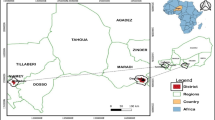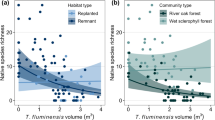Abstract
Shortgrass steppe rangeland near Nunn, Colorado, USA, has been lightly,moderately, or heavily grazed by cattle, or protected from grazing inexclosures, for 55 years. Plant species biodiversity and evenness were greatestin lightly- and moderately-grazed pastures. Both pastures weredominated by the warm-season shortgrass Boutelouagracilis, but the cool-season midgrasses Pascopyrumsmithii and Stipa comata contributedsignificantly to biomass production on the lightly-grazed pasture, asthey did in the exclosures. Diversity was least in the exclosures, which werestrongly dominated by the cactus Opuntia polyacantha.Buchloë dactyloides, another warm-seasonshortgrass, and Bouteloua gracilis were co-dominantsunder heavy grazing, and diversity was intermediate. Plant community structureand diversity were controlled by selective grazing by cattle and soildisturbance by cattle and rodents. Shortgrass steppe moderately or heavilygrazed by cattle was similar to and probably as sustainable as steppe grazed formillenia by bison and other wild ungulates.
Similar content being viewed by others
References
Anderson V.J. and Briske D.D. 1995. Herbivore-induced species replacement in grasslands: Is it driven by herbivory tolerance or avoidance? Ecol. Appl. 5: 1014–1024.
Archer S., Garrett M.G. and Detling J.K. 1987. Rates of vegetation change associated with prairie dog (Cynomys ludovicianus) grazing in North American mixed-grass prairie. Vegetatio 72: 159–166.
Biondini M.E., Patton B.D. and Nyren P.E. 1998. Grazing intensity and ecosystem processes in a northern mixed-grass prairie, USA. Ecol. Appl. 8: 469–479.
Brown J.H. and Heske E.J. 1990. Control of a desert-grassland transition by a keystone rodent guild. Science 250: 1705–1707.
Collins S.L. 1987. Interaction of disturbances in tallgrass prairie: A field experiment. Ecol. 68: 1243–1250.
Collins S.L., Knapp A.K., Briggs J.M., Blair J.M. and Steinauer E.M. 1998. Modulation of diversity by grazing and mowing in native tallgrass prairie. Science 280: 745–747.
Duncan P. and Jarman P.J. 1993. Conservation of biodiversity in managed rangelands, with special emphasis on the ecological effects of large grazing ungulates, domestic and wild. In: Baker M.J. (ed.), Grasslands for Our World. SIR Publishing, Wellington, pp. 776–783.
England R.E. and DeVos A. 1969. Influence of animals on pristine conditions on the Canadian grasslands. J. Range Manage. 22: 87–94.
Fisser H.G., Lester J.E., Mitchell G.C. and Bledsoe L.J. 1969. Preliminary report of methodology and results for analyses of plant pattern project research on the Pawnee Site. US IBP Grassland Biome Tech. Rep. 9.
Fuhlendorf S.D. and Smeins F.E. 1997. Long-term vegetation dynamics mediated by herbivores, weather and fire in a Juniperus-Quercus savanna. J. Veg. Sci. 8: 819–828.
Guo Q. and Rundel P.W. 1997. Measuring dominance and diversity in ecological communities: choosing the right variables. J. Veg. Sci. 8: 405–408.
Hansen R.M. and Gold I.K. 1977. Blacktail prairie dogs, desert cottontails, and cattle trophic relations on shortgrass range. J. Range Manage. 30: 210–214.
Hart R.H. and Ashby M.M. 1998. Grazing intensities, vegetation, and heifer gains: 55 years on shortgrass. J. Range Manage. 51: 392–398.
Hart R.H. and Hart J.A. 1997. Rangelands of the Great Plains before European settlement. Rangelands 19: 4–11.
Hartnett D.C., Hickman K.R. and FischerWalter L.E. 1996. Effects of bison grazing, fire, and topography on floristic diversity in tallgrass prairie. J. Range Manage. 49: 413–420.
Heltshe J.F. and Forrester N.E. 1983. Estimating species richness using the jackknife procedure. Biometrics 39: 1–11.
Hobbs N.T., Schimel D.S., Owensby C.E. and Ojima D.S. 1991. Fire and grazing in the tallgrass prairie: Contingent effects on nitrogen budgets. Ecol. 72: 1374–1382.
Hobbs R.J. and Huenneke L.F. 1992. Disturbance, diversity, and invasion: Implications for conservation. Cons. Biol. 6: 324–337.
Jefferies R.L., Klein D.R. and Shaver G.R. 1994. Vertebrate herbivores and northern plant communities: Reciprocal influences and responses. Oikos 71: 193–206.
Johnson H.B. and Mayeux H.S. 1992. A view of species additions and deletions and the balance of nature. J. Range Manage. 45: 322–333.
Kautz J.E. and Van Dyne G.M. 1978. Comparative analyses of diets of bison, cattle, sheep, and pronghorn antelope on shortgrass prairie in northeastern Colorado, U.S.A. In: Hyder D.N. (ed.), Proc. 1st Rangeland Congr. Soc. Range Management., Denver, CO, pp. 438–443.
Klipple G.E. and Costello D.F. 1960. Vegetation and cattle responses to different intensities of grazing on short-grass ranges on the Central Great Plains. In: US Dept. Agric. Tech. Bull. 1216. US Govt. Print. Office, Washington DC US Dept. Agric. Tech. Bull. 1216. US Govt. Print. Office, Washington DC.
Larson F. 1940. The role of bison in maintaining the short grass plains. Ecol. 21: 113–121.
Lauver C.L. 1997. Mapping species diversity patterns in the Kansas shortgrass region by integrating remote sensing and vegetation analysis. J. Veg. Sci. 8: 387–394.
Lester J.E. and Fisser H.G. 1970. Opuntia clump size variation on the shortgrass plains, Pawnee Site, Nunn, Colorado. J. Colo.-Wyo. Acad. Sci. 7: 37–38.
Magurran A.E. 1988. Ecological Diversity and Its Measurement. Princeton Univ. Press, Princeton, New Jersey.
McNaughton S.J. 1994. In: Schulze E.-D. and Mooney H.A. (eds), Biodiversity and Ecosystem Function. Springer-Verlag, Berlin, pp. 361–383.
McNaughton S.J., Banykiwa F.F. and McNaughton M.M. 1997. Promotion of the cycling of diet-enhancing nutrients by African grazers. Science 278: 1798–1800.
Milchunas D.G., Lauenroth W.K. and Chapman P.L. 1992. Plant competition, abiotic, and long-and short-term effects of large herbivores on demography of opportunistic species in a semiarid grassland. Oecologia 92: 520–531.
Milchunas D.G., Lauenroth W.K., Chapman P.L. and Kazempour M.K. 1990. Community attributes along a perturbation gradient in a shortgrass steppe. J. Veg. Sci. 1: 375–384.
Milchunas D.G., Sala O.A. and Lauenroth W.K. 1988. A generalized model of the effects of grazing by large herbivores on grassland community structure. Amer. Natur. 132: 87–106.
Paine R.T. 1966. Food web complexity and species diversity. Amer. Natur. 100: 65–75.
Pielou E.C. 1966. Species-diversity and pattern-diversity in the study of ecological succession. J. Theoret. Biol. 10: 370–383.
Plumb G.E. and Dodd J.L. 1993. Foraging ecology of bison and cattle on a mixed prairie: Implications for natural area management. Ecol. Appl. 3: 631–643.
Risser P.G. 1971. Plant community structure. In: French N.R. (ed.), The Grassland Biome: Analysis and Synthesis of First Year Data. Range Sci. Dept. Sci. Ser. 10. Colorado State University, Fort Collins, CO, pp. 41–58.
Risser P.G., Birney E.C., Blocker H.D., May S.W., Parton W.J. and Wiens J.A. 1981. The True Prairie Ecosystem. Hutchinson Ross, Stroudsburg, Pennsylvania.
Schuman G.E., Reeder J.D., Manley J.T., Hart R.H. and Manley W.A. 1999. Impact of grazing management on the carbon and nitrogen balance of a mixed-grass rangeland. J. Ecol. Appl. 9: 65–71.
Schwartz C.C. and Ellis J.E. 1981. Feeding ecology and niche separation in some native and domestic ungulates on the shortgrass prairie. J. Appl. Ecol. 18: 343–353.
Shannon C.E. and Weaver W. 1949. The Mathematical Theory of Communication. Univ. Illinois Press, Urbana, IL.
Shoop M.S. and McIlvain E.H. 1963. The micro-unit forage inventory method. J. Range Manage. 16: 172–179.
Simpson E.H. 1949. Measurement of diversity. Nature 163: 688.
Singh J.S., Bourgeron P. and Lauenroth W.K. 1996. Plant species richness and species-area relations in a shortgrass steppe in Colorado. J. Veg. Sci. 7: 645–650.
Tilman D., Lehman C.L. and Thomson K.T. 1997. Plant diversity and ecosystem productivity: theoretical considerations. Proc. Natl. Acad. Sci. 94: 1857–1861.
Vavra M., Rice R.W., Hansen R.M. and Sims P.L. 1977. Food habits of cattle on shortgrass range in northeastern Colorado. J. Range Manage. 30: 261–263.
Weltzin J.F., Archer S. and Heitschmidt R.K. 1997. Small-mammal regulation of vegetation structure in a temperate savanna. Ecol. 78: 751–763.
West N.E. and Whitford W.G. 1995. The intersection of ecosystem and biodiversity concerns in the management of rangelands. In: West N.E. (ed.), Biodiversity on Rangelands. Utah State University, Logan, UT, pp. 72–79.
Whittaker R.H. 1965. Dominance and diversity in land plant communities. Science 147: 250–260.
Woodward F.I. 1994. How many species are required for a functional ecosystem? In: Schulze E.-D. and Mooney H.A. (eds), Biodiversity and Ecosystem Function. Springer-Verlag, Berlin, pp. 271–291.
Wright H.A. and Bailey A.W. 1980. Fire ecology and prescribed burning in the Great Plains-a research review. In: USDA Forest Serv. Gen. Tech. Rep. INT-77. USDA Forest Serv. Gen. Tech. Rep. INT-77.
Author information
Authors and Affiliations
Rights and permissions
About this article
Cite this article
Hart, R.H. Plant biodiversity on shortgrass steppe after 55 years of zero, light, moderate, or heavy cattle grazing. Plant Ecology 155, 111–118 (2001). https://doi.org/10.1023/A:1013273400543
Issue Date:
DOI: https://doi.org/10.1023/A:1013273400543




